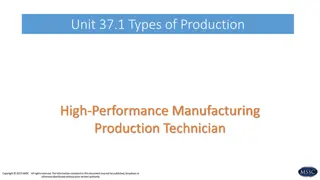Understanding Confectionery Production Principles
Confectionery is a beloved food enjoyed by many. This article delves into the art of making confections, the classification of confectionery types, and the key ingredients and principles behind sugar confectionery production. Topics covered include sugar confectionery groups, raw materials used, and the importance of equilibrium relative humidity and sugar solubility in the confectionery-making process.
Download Presentation

Please find below an Image/Link to download the presentation.
The content on the website is provided AS IS for your information and personal use only. It may not be sold, licensed, or shared on other websites without obtaining consent from the author. Download presentation by click this link. If you encounter any issues during the download, it is possible that the publisher has removed the file from their server.
E N D
Presentation Transcript
CONFECTIONARY PRODUCTS B.K.SINGH,DAIRY TECHNOLOGY
CONFECTIONERY Confectionery is an important food and popular among wide range of population. It has been used as a major food delicacy from ancient times. Confectionery is the art of making confections, which are food items that are rich in sugar and carbohydrates. In general, confectionery is divided into two broad and somewhat overlapping categories, bakers' confections and sugar confections. The confectionery term is a spectrum of sweet goods and known with different meaning depending on the region in which it is used, for example in the U. K. the term used to any sweet product including cakes. In the United States confectionery includes candy, sugar confectionery and chocolate confectionery.
CLASSIFICATION OF CONFECTIONERY Sugar confectionery Chocolate confectionery Flour confectionery Milk-based confectionery
SUGAR CONFECTIONERY GROUPS Amorphous sugar confectionery Crystalline sugar confectionery
RAW MATERIALS AND INGREDIENTS USED IN SUGAR CONFECTIONERY Sucrose Sucrose derivatives Glucose syrups Honey Intense sweeteners Bulk sweeteners Fats Emulsifiers Milk products Gelling agents, thickeners and stabilizers Colours Flavours
CONFECTIONERY PRODUCTION PRINCIPLES Key ingredients used in sugar confectionery: The major ingredients of the sugar confectionery are sugar, glucose syrup or invert sugar and water. The purpose of using reducing sugars is to control or prevent crystallization ; whether crystallization occurs or not, it is required that the level of dissolved solids in the water should never less than 76% in order to prevent microbial deterioration. Equilibrium relative humidity:The relative humidity of the sweet atmosphere is a state, where it neither gains nor loses the moisture is termed as equilibrium relative humidity (ERH) of the sweet and is a function of its water vapour pressure. This is dependent on the moisture content of the sweet, or of the liquid portion in the case of sweets containing liquid and solid components. Sugar solubility:Sugar dissolves in water to give a saturated solution of 67.1% solids at 20 undisturbed sugar syrup will not crystallize unless seed crystal is present or mechanical or thermal shock is encountered. This metastable state is utilized in the wet crystallization process. The presence of invert sugar or glucose syrup increases solubility of sugar and TSS in solution at saturation C. However, up to 74% solids,
CONFECTIONERY PRODUCTION PRINCIPLES Sugar boiling:The amount of water evaporated when a sugar solution is boiled under constant conditions is related to the boiling temperature. Water boils at 100 C under standard atmospheric conditions. The addition of sucrose, or any other sugar, increases the boiling point in a non-linear manner and is related to the concentration of sugar in solution. Sugar crystallization:When a supersaturated solution is seeded with existing crystals, usually by the addition of fondant, crystallization occurs throughout the mass. The crystal size may be controlled by varying the degree of supersaturation, the amount of seed crystal and the temperature. Aeration:Aeration may be applied for a number of reasons such as increasing volume for a given weight of product and creating opacity, but the main reason is texture modification.
CONFECTIONERY PRODUCTION PROCESSES Cooking:Cooking of sugar is usually carried out in either gas fired cooking pans or in steam-jacketed kettles. Drop rolling:The drop roller was one of the earliest sweet forming machines. It consists of two synchronized brass rolls engraved with matching impressions. Moulding:Depending on the type, confectionery products are moulded in different shapes. Boiled sweets are deposited into teflon-coated aluminium moulds fitted with ejector pins. After cooling, the pins are depressed from the underside of the moulds to eject the solid boilings. Extrusion : Extruders of various types are used for forming bars and sheets from pastes and plastic confectionery bases. Lozenges are formed by passing the paste through a screw extruder and die to form a sheet which is then reduced in thickness by subsequent sizing rollers. In case of bars, the sheets are slit by rotary knives and sized to desired length.
CONFECTIONERY PRODUCTION PROCESSES Plastic forming: The plastic forming operation is widely used in the confectionery industry for converting plastic masses such as boiled sugar or toffee into individual sweets. In this process, the product will be tempered to correct consistency and flavour ingredients incorporated during the kneading process in the case of boiled sugar, cooling drum or cooling conveyor in the case of toffees. The mass is then fed into a batch roller for obtaining the product in the form of a rope. The rope is the fed to a pressurizer followed by sweet former (to give desired shape to final product) and later packaged. Wet crystallizing :Wet crystallizing is the process of building up a thin coherent coating of sugar crystal on the surface of a sweet. This seals the surface, and when used on products such as fondant creams or marzipan, retards drying out, extending the shelf life from a few days to 6 months or more.
CONFECTIONERY PRODUCTION PROCESSES Panning:Panning is an operation which has been used by the confectionaries for centuries. In principle it is the application of coating to centres tumbling in a revolving pan mounted at about 30 to the horizontal. The operation consists of adding enough coating medium to cover the centres completely with no surplus and drying this off either with hot air (hard panning), extra sugar (soft panning) or cold air (for chocolate). Coatings may be sugar syrup (hard panning), glucose syrup dried off by the application of fine sugar (soft panning) or chocolate, solutions containing food grade colours, edible gums, etc.
CANDIES Candies represent a subgroup of amorphous sugar confectionery which are characterized by hard, chewy, homogenous and non-crystalline nature. These are also called as glass. The glassy state of matter is not a thermodynamic phase but a supercooled liquid and exhibit a sharp transition temperature between glassy and rubber states. Most sugars will form a glass but pure sucrose does not form a glass. Therefore, commercial sugar glasses are always made from sucrose and some other sugars such as invert sugar, glucose syrup, etc. Any additive required to stabilize a sucrose glass is traditionally referred to as a doctor by confectioners. Sometimes, acids are added to sucrose for in situ generation of invert sugar. In practice, boiled sweets (or high boilings) become unstable by absorbing water. Initially the product becomes sticky, then soft, followed ultimately by crystallization.
HARD BOILED CANDIES The process of making boiled candies can be summarized as follow: a. Dissolving the sugar b. Boiling the sugar and glucose syrup under vacuum to the final solids concentration c. Cooling the boiled mass d. Adding flavour, colour and any acid e. Shaping the product f. Wrapping
BRITTLE Brittle is essentially a type of hard candy to which nuts like peanuts are very commonly added. The nuts are added to the hot syrup and the mixture is poured out in a very thin layer and then stretched to make it as thin as possible. Baking soda (sodium bicarbonate) is sometimes added to produce a light texture. The resulting candy is hard and snaps easily, hence the term brittle .
COMPRESSED TABLETS Candies produced by application of high pressure processing are called compressed tablets or pressed candies. It involves use of punches and dies to provide desired shape. For tablet sweets, icing sugar and dextrose are normally used as a base, with gelatin, gum acacia or gum guar as binding materials. Stearic acid and its salts are normally used as lubricants. The amount of binding agent and lubricant used in compounding the formulation influences the physical properties of the tablet. There are two methods of producing compressed tablets: slugging and wet granulation. In slugging, the powder mix is treated with a lubricant before precompression into large granules.
CRYSTALLINE FONDANTS AND CREAMS Fondants are more solid and are used in preparing items such as peppermint patties, while creams are softer and used in making chocolate covered products. The main difference is in the degree of hardness and crystal size. All fondants are prepared from a blend of sucrose and other sugars such as invert syrup or corn syrup. Blend is usually heated to a temperature of 115- 120 C and cooled to about 37.8 initiates crystallization to produce a product with a crystal size of about 15 m. C without agitation. When agitated, it























